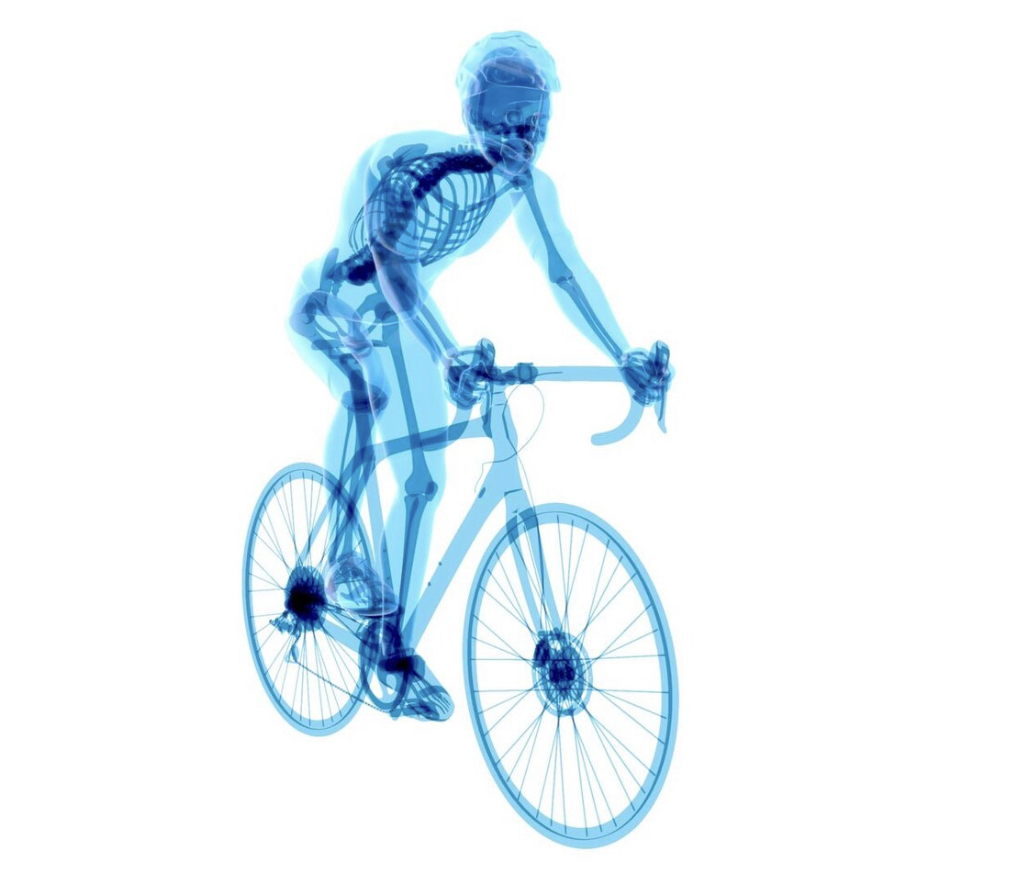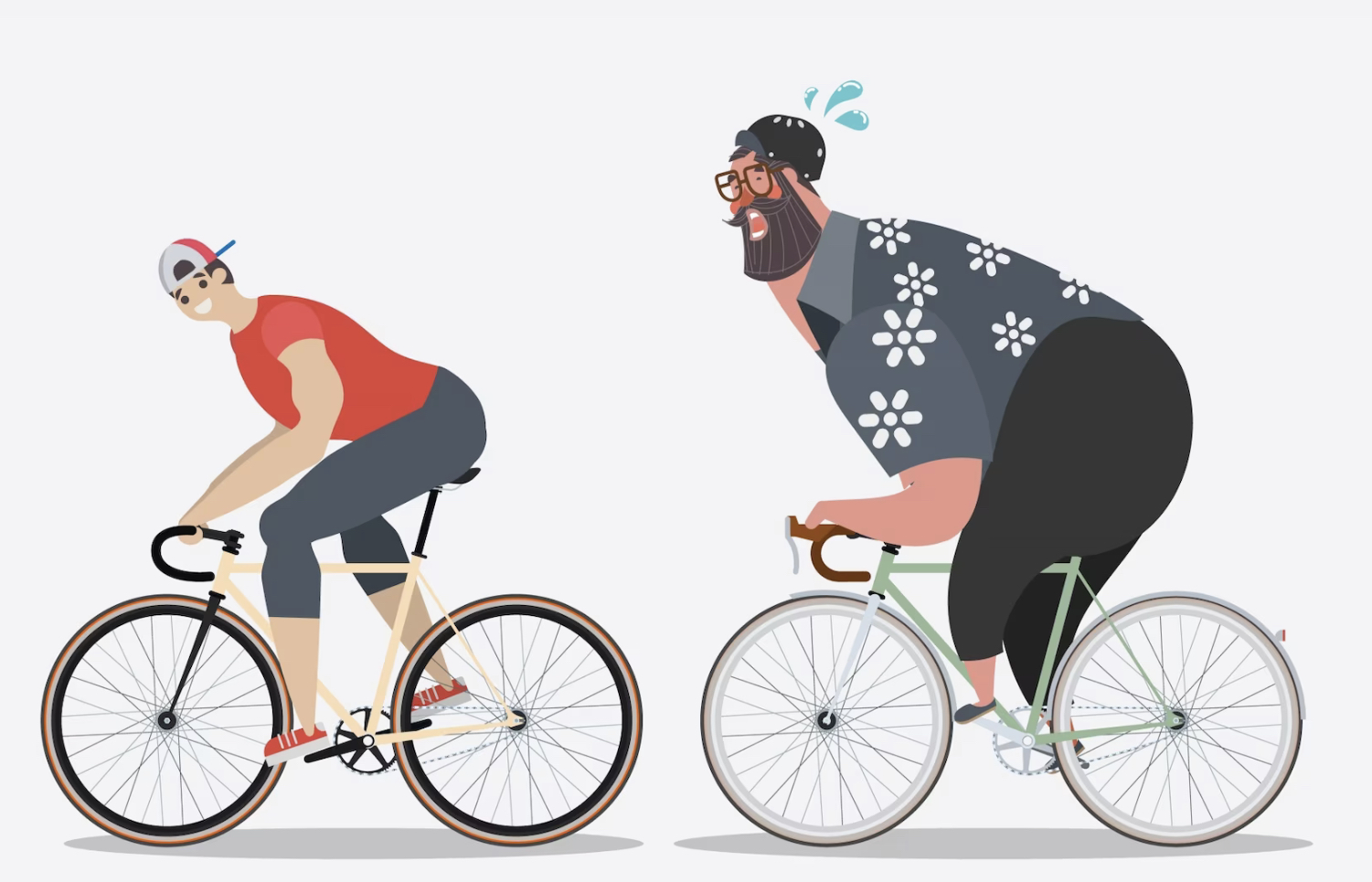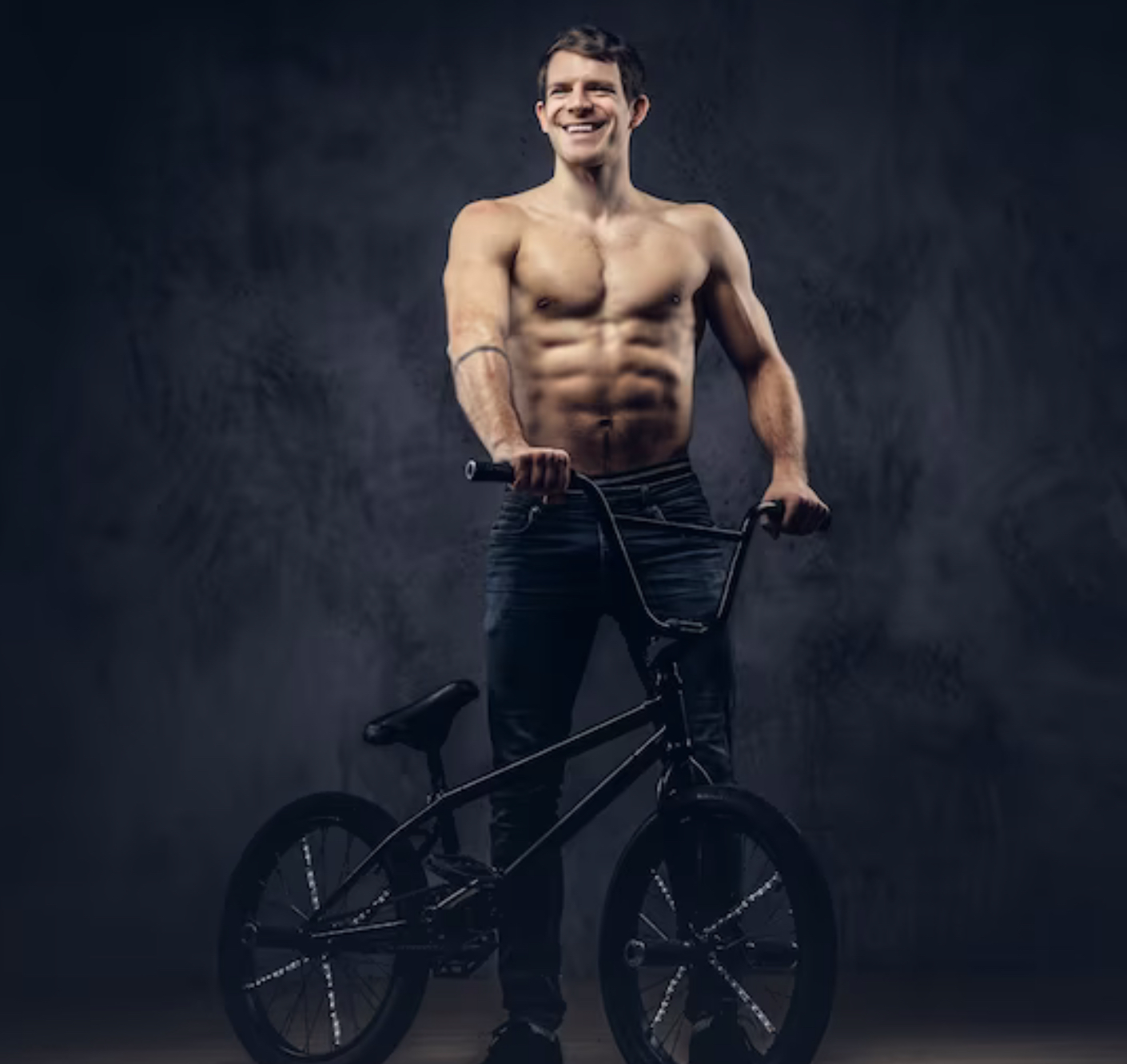
Do you have to be skinny to be a cyclist? No, you absolutely do not have to be skinny to be a cyclist. Cycling is a versatile sport that accommodates people of various body types and sizes.
Cyclists come in all shapes and forms, and what truly matters is your passion for riding and the joy it brings.
Whether you’re aiming for speed, endurance, or simply the pleasure of a leisurely bike ride, anyone can embrace cycling as a healthy and enjoyable activity, regardless of their body size.
The key is to stay active, have fun, and savour the freedom of the open road, regardless of your body type.
Is there a weight limit for cycling?
There is no weight limit for cycling but some products, such as carbon frames and wheels have a rider weight limit.
Am I too fat to ride a bike?
NO! Anyone can ride a bike and cycling is the best exercise for weight management and body re-composition.
Does body weight affect cycling?
Yes, body weight can affect cycling performance to some extent. The impact of body weight on cycling depends on the type of cycling and the specific goals of the cyclist:
- Uphill Performance: In road cycling or mountain biking, a lighter body weight can provide an advantage when climbing hills. This is because less weight to carry uphill can make the climb easier and potentially faster.
- Downhill and Flat Terrain: On flat terrain and downhill sections, weight has less of an impact on speed and can even be an advantage in terms of stability and momentum.
- Endurance Cycling: For long-distance or endurance cycling, body weight may not be as critical as overall fitness and stamina. Cyclists of various body sizes and weights can excel in endurance events.
- Sprinting and Power: In disciplines like track cycling or short-distance sprinting, having a combination of strength and power can be more critical than body weight.
- Aerodynamics: Body shape and size can also influence aerodynamics, which is important in time trials and racing. Reducing aerodynamic drag can improve performance, and body position on the bike matters.
Ultimately, it’s essential to find a balance that suits your cycling goals. Proper training, nutrition, and bike fit can help cyclists optimise their performance regardless of their body weight.
Cyclists should focus on overall fitness, technique, and training tailored to their objectives, rather than solely fixating on weight.
Can a cyclist be muscular?
Yes, a cyclist can certainly be muscular.
While the stereotypical image of a cyclist often includes a lean and slender physique, it’s important to recognise that cyclists come in a wide range of body types, and muscular cyclists are not uncommon. Muscular cyclists can excel in various cycling disciplines, including road cycling, mountain biking, and even track cycling. Here are a few key points to consider:
- Different Cycling Disciplines: Muscular cyclists can be particularly well-suited for disciplines that require explosive power, like sprinting or track cycling. They can generate more force during short bursts of speed.
- Sprinting Ability: Muscles can provide an advantage in sprinting situations, as powerful leg muscles can help propel a cyclist forward with force and speed.
- Endurance and Muscle: Muscular endurance, which is the ability to sustain muscular effort over extended periods, can also be beneficial in long-distance cycling events.
- Strength and Hills: Muscular individuals may perform well in hilly or mountainous terrain, as they can generate the power needed to climb steep slopes.
- Body Composition: Cyclists who are both muscular and lean can strike a balance between strength and power while still benefiting from reduced body weight for uphill climbs.
Can an overweight person ride a road bike?
Yes absolutely. There are plenty of bikes for heavier riders to enjoy road cycling.
If you are looking in to carbon based products (framesets and wheels) then check the rider weight limit.
Do heavier people burn more calories biking?
Yes, heavier individuals typically burn more calories while biking compared to lighter individuals. This is primarily due to the increased energy required to move a heavier body against gravity and to overcome rolling resistance. Here’s why this happens:
- Energy Expenditure: The energy required for cycling is determined by the work done against gravity and friction (rolling resistance) as well as air resistance. Heavier individuals must overcome greater gravitational resistance, which means they use more energy to climb hills or accelerate from a stop.
- Increased Work: When a cyclist with more body weight pedals, they need to apply more force to the pedals to move their weight and the bike. This additional force translates into more energy expenditure.
- Power Output: Heavier individuals may produce more power, especially when pedaling uphill. The power output is a product of the force applied to the pedals and the speed of pedaling, and a greater force can result in higher power output.
- Heart Rate and Metabolism: Heavier individuals might experience an elevated heart rate and increased metabolic rate while cycling, which can lead to a higher calorie burn.
However, it’s important to note that the relationship between body weight and calorie expenditure is not linear.
While heavier individuals burn more calories due to the increased work required, there are diminishing returns, as other factors, such as fitness level, bike efficiency, and riding conditions, also play a role.
Additionally, a cyclist’s fitness level and cycling intensity have a significant impact on calorie burn. Even a lightweight cyclist can burn a substantial number of calories by cycling at a high intensity or covering long distances.
Are lighter cyclists faster?
Lighter cyclists may have an advantage when it comes to speed in certain cycling situations, but it’s essential to consider various factors that influence cycling performance. Weight is just one piece of the puzzle. Here are some factors to consider:
- Climbing: Lighter cyclists often have an advantage when climbing steep hills because they have less body weight to carry uphill. This means they can ascend hills more quickly and efficiently, all else being equal.
- Acceleration: Lighter cyclists can accelerate more quickly because they have less inertia to overcome. This can be an advantage when sprinting or making quick changes in pace during a race.
- Aerodynamics: A cyclist’s body position and equipment also play a significant role in speed. Lighter cyclists may have an edge in achieving an aerodynamic position, but this depends on factors like body shape and flexibility.
- Endurance: While lighter riders have an advantage in climbing and acceleration, heavier cyclists may have an advantage in flat terrain or during longer time trials where they can use their power and momentum to maintain a steady speed.
- Muscle Strength: Cyclists with more muscle mass, whether they are lighter or heavier, can generate more power, which can be advantageous in various situations, such as sprinting or maintaining high speeds.
In reality, cycling performance is a complex interplay of many factors, including a rider’s fitness, technique, bike setup, strategy, and the specific type of race or ride. Lighter cyclists may excel in some aspects, while heavier cyclists may shine in others.
The key is to optimise your strengths and work on your weaknesses.
What is an ideal body for cyclist?
The ideal body for a cyclist can vary depending on the specific cycling discipline. Different types of cycling emphasize various aspects of physical fitness, and the ideal body type for each discipline can reflect these differences. Here’s how body types can vary by discipline:
- Road Cycling: For long-distance road cycling or endurance events, an ideal body type often includes a lean and aerodynamic build. Cyclists who excel in this discipline tend to have a low percentage of body fat, good cardiovascular endurance, and the ability to maintain a steady pace for extended periods.
- Sprinting and Track Cycling: Sprinters and track cyclists require explosive power and strength, making a more muscular build advantageous. They often have well-developed leg muscles and upper body strength, which helps with powerful bursts of speed.
- Mountain Biking: Mountain bikers need a combination of strength and endurance. While being lean and having strong leg muscles are beneficial, they also need upper body strength and the ability to handle rough, technical terrain.
- Cyclocross: Cyclocross racers need to be adaptable and able to dismount, carry their bikes, and navigate challenging terrain. A well-rounded body type with both strength and endurance is an advantage.
- Time Trials and Triathlons: In time trials and triathlons, aerodynamics play a crucial role. Cyclists with a streamlined body shape and the ability to maintain a low, aero position can excel.
- BMX and Downhill: These disciplines require riders to be agile, strong, and fearless. Muscular leg strength, balance, and quick reflexes are key.
It’s important to note that there is no one-size-fits-all ideal body type for cycling.
What matters most is finding a body type and fitness level that align with your personal goals and the discipline you enjoy the most. Cyclists come in various shapes and sizes, and success in the sport is determined by a combination of physical fitness, skill, and passion for the chosen discipline.
What do cyclists bodies look like?
Cyclists’ bodies can vary widely based on factors such as their training focus, genetics, and the specific cycling discipline they pursue. Here are some common features and characteristics often associated with cyclists’ bodies:
- Lean and Toned: Many road cyclists, especially those focusing on endurance and long-distance events, tend to have lean and well-defined bodies. They often have low body fat percentages, which help improve their power-to-weight ratio for climbing.
- Strong Leg Muscles: Cyclists, regardless of discipline, typically have well-developed leg muscles, particularly the quadriceps and calves. These muscles are crucial for generating power to pedal.
- Muscular Upper Bodies (for certain disciplines): Sprinters and track cyclists may have more muscular upper bodies, as they require strong arms and shoulders for powerful sprints.
- Aerodynamic Position: Cyclists who focus on aerodynamics and time trials may have flatter backs and elongated positions to reduce wind resistance.
- Calf Definition: Cyclists often have defined calf muscles due to the constant pedaling motion.
- Balanced Upper Body Strength (for mountain bikers): Mountain bikers may have a more balanced upper body strength to handle the technical challenges of off-road terrain.
- Low Body Fat: Lower body fat percentages are common in cyclists, especially in road cycling, to improve their power-to-weight ratio and overall performance.
- Flexibility: Cyclists tend to have good flexibility, particularly in the hamstrings and hip flexors, to maintain efficient riding positions.
Are cyclists the fittest athletes?
If you ask a cyclist the answer will be : YES!
Cyclists are among the fittest athletes in the world, but whether they are the “fittest” is subjective and depends on the criteria used for assessing fitness.
Cyclists possess high levels of cardiovascular endurance, muscular strength and endurance, and specific skill sets that make them incredibly fit within the context of their sport. However, the “fittest” athlete may vary based on the specific attributes being measured.

Cycling is a wonderfully inclusive sport that welcomes individuals of all body types and sizes.
“A bicycle ride is a flight from sadness.” -James E. Starrs







